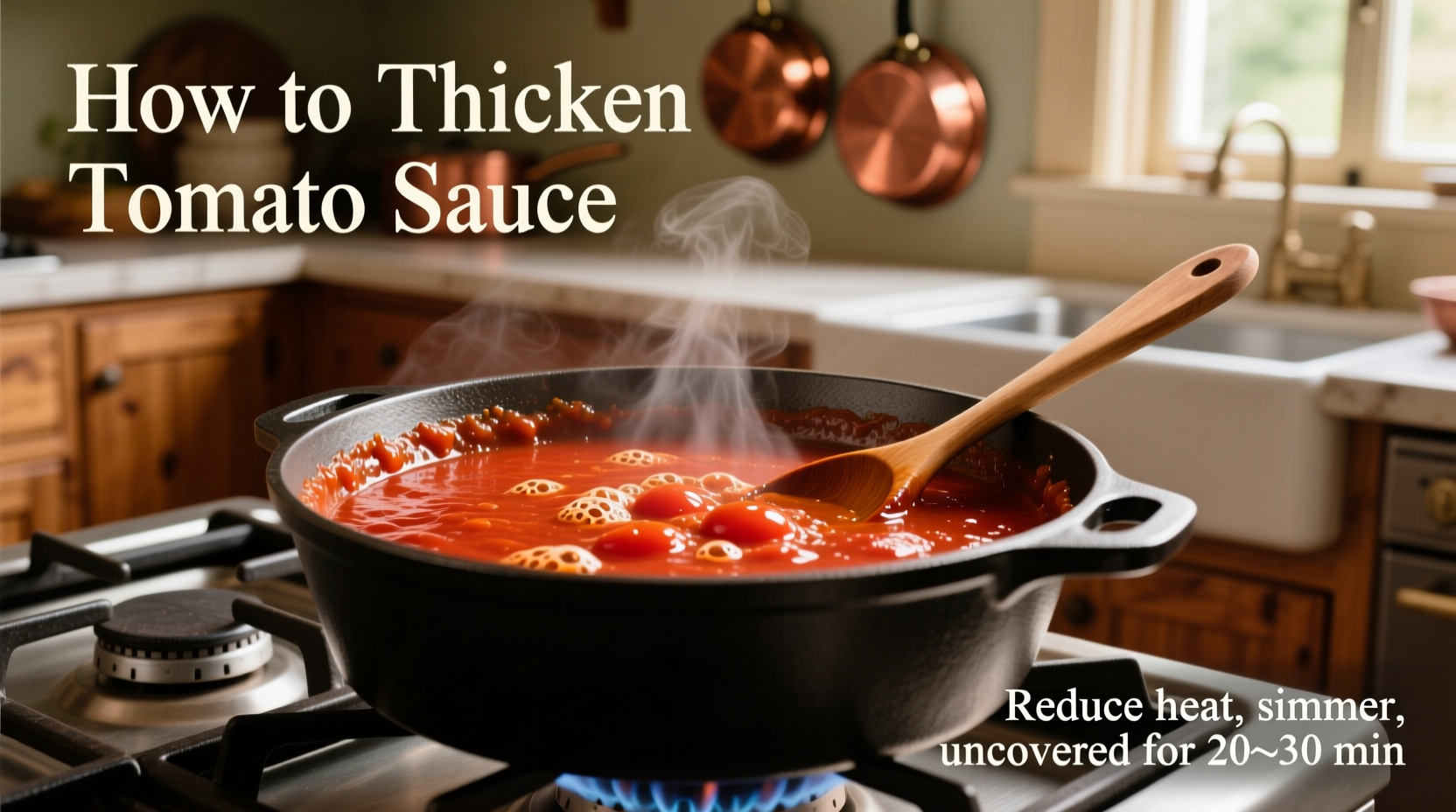Thicken tomato sauce effectively by simmering to reduce liquid, adding tomato paste for concentrated flavor, or using a cornstarch slurry for quick results. Simmer uncovered for 20-30 minutes for the most natural method, or mix 1 tablespoon cornstarch with 1 tablespoon cold water per cup of sauce for instant thickening without altering flavor significantly.
Every cook has faced the frustration of watery tomato sauce clinging to pasta instead of coating it properly. Whether you're making marinara from scratch or adjusting a store-bought jar, achieving that perfect restaurant-quality consistency transforms an ordinary meal into something special. The good news? Thickening tomato sauce is simpler than you think, and you likely have everything you need in your kitchen right now.
Why Your Tomato Sauce Might Be Too Thin
Understanding why your sauce is runny helps you choose the best thickening approach. Common culprits include:
- Excess liquid from canned tomatoes (especially lower-quality brands)
- Adding too much pasta water during finishing
- Not cooking the sauce long enough to reduce naturally
- Using watery fresh tomatoes in season
- Adding ingredients like vegetables that release moisture
Before reaching for thickeners, assess your sauce's current state. If it's only slightly thin, a brief simmer might be all you need. If it's extremely watery, you'll need a more aggressive approach.
7 Proven Methods to Thicken Tomato Sauce
1. Simmering and Reduction (The Chef's Preferred Method)
Professional chefs overwhelmingly choose reduction as their primary thickening technique. Simply simmer your sauce uncovered over medium-low heat, stirring occasionally to prevent sticking. As water evaporates, the sauce naturally concentrates.
Time required: 20-45 minutes depending on initial thinness
Best for: All tomato sauce varieties
Pro tip: Keep heat low to preserve fresh tomato flavor—boiling too vigorously can create a "cooked" taste.
2. Tomato Paste Boost (Flavor-Enhancing Option)
Adding tomato paste simultaneously thickens and intensifies flavor. For every cup of thin sauce, stir in 1-2 tablespoons of tomato paste and simmer for 10 minutes.
According to culinary research from the Culinary Institute of America, tomato paste contains approximately 24-28% solids compared to 8-12% in regular tomato sauce, making it an efficient thickener that enhances rather than masks flavor.
3. Cornstarch Slurry (Quick Emergency Fix)
When time is critical, a cornstarch slurry works in minutes. Whisk together equal parts cornstarch and cold water (1 tablespoon each per cup of sauce) until smooth, then gradually stir into simmering sauce.
Critical step: Bring the sauce back to a full boil for 1 minute to activate cornstarch's thickening power. This method works particularly well for delicate sauces where flour might alter flavor.
4. Roux (For Creamy Tomato Varieties)
For tomato bisques or creamy tomato sauces, a light roux (equal parts butter and flour cooked briefly) creates luxurious texture. Melt 1 tablespoon butter, whisk in 1 tablespoon flour, cook 1 minute, then gradually whisk in sauce.
5. Arrowroot (Gluten-Free Alternative)
Similar to cornstarch but with a clearer finish, arrowroot works well for tomato sauces where appearance matters. Use a 1:1 ratio with cornstarch but don't boil after adding—high heat breaks down arrowroot's thickening properties.
6. Mashed Potatoes (Surprising Home Hack)
Many Italian nonnas use this trick: stir in a small amount of mashed potatoes (about 1 tablespoon per cup of sauce). The starches thicken without altering flavor significantly. This method appears in traditional Italian cookbooks dating back to the 1950s as a resourceful solution during post-war ingredient shortages.
7. Breadcrumbs (For Meat-Based Sauces)
When making meat sauces like Bolognese, stir in 1-2 tablespoons of plain breadcrumbs. They absorb excess liquid while adding body. This technique follows the Italian culinary principle of "ammazzare il sugo" (killing the sauce)—finishing with starch to perfect consistency.
| Thickening Method | Time Required | Flavor Impact | Best Sauce Types |
|---|---|---|---|
| Simmering/Reduction | 20-45 min | Concentrates flavor positively | All types |
| Tomato Paste | 10-15 min | Enhances tomato flavor | Marinara, Arrabbiata |
| Cornstarch Slurry | 5-10 min | Neutral | Delicate sauces |
| Roux | 10-15 min | Slight richness | Creamy tomato sauces |
Choosing the Right Method for Your Situation
Your choice depends on three factors: time available, sauce type, and dietary needs. Consider these scenarios:
- Emergency dinner situation: Cornstarch slurry works fastest (5-10 minutes)
- Making Sunday gravy: Simmering for 30+ minutes develops superior flavor
- Gluten-free requirement: Arrowroot or cornstarch instead of roux
- Preserving fresh tomato taste: Simmer gently rather than boiling vigorously
Avoid common pitfalls like adding thickeners to cold sauce (causes clumping) or using too much (creates gummy texture). Always add thickener gradually—you can always add more, but you can't remove it.

Troubleshooting Thickening Problems
Even experienced cooks encounter issues. Here's how to fix them:
Sauce Became Too Thick
Gradually whisk in small amounts of warm broth, water, or reserved pasta cooking water until desired consistency returns. Start with 1 tablespoon at a time.
Sauce Separated After Thickening
This happens when cornstarch or arrowroot isn't properly activated. Return sauce to gentle simmer while whisking constantly for 2-3 minutes. For roux-thickened sauces, ensure you cooked the roux sufficiently before adding liquid.
Flavor Became Muted
Thickening can sometimes mute flavors. Brighten with a splash of red wine vinegar, squeeze of lemon, or pinch of red pepper flakes. Fresh basil added at the end also revitalizes flavor.
Pro Tips from Professional Kitchens
Professional chefs employ these advanced techniques for perfect sauce consistency every time:
- Timing is everything: Add thickeners during the last 15-20 minutes of cooking for optimal integration
- The plate test: Run your finger across a spoonful of sauce—it should leave a clear path that doesn't immediately fill in
- Reserve pasta water: The starchy water helps sauce cling to pasta and can adjust consistency during finishing
- Cooling effect: Sauce thickens slightly as it cools, so aim for slightly thinner consistency than desired when hot
According to food science research published in the Journal of Food Science, tomato sauce reaches ideal viscosity between 1,500-2,500 centipoise—the same thickness as light cream. This range allows proper coating of pasta without being gloppy.
Storage Considerations
Thickened sauces behave differently when stored. Sauces thickened with cornstarch or arrowroot may thin slightly when reheated, while reduced sauces maintain consistency better. When freezing, leave extra headspace as sauces expand, and note that roux-thickened sauces may separate slightly upon thawing (a quick whisk while reheating fixes this).











 浙公网安备
33010002000092号
浙公网安备
33010002000092号 浙B2-20120091-4
浙B2-20120091-4